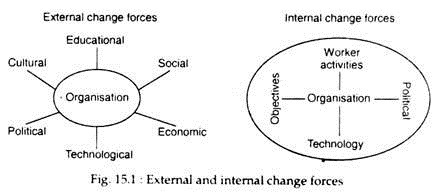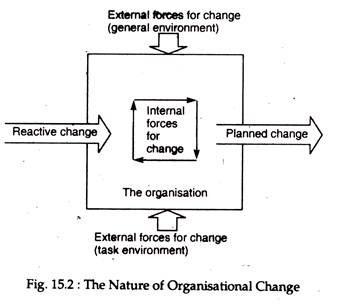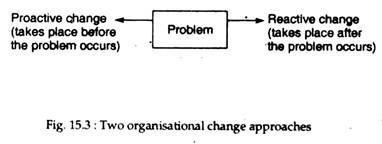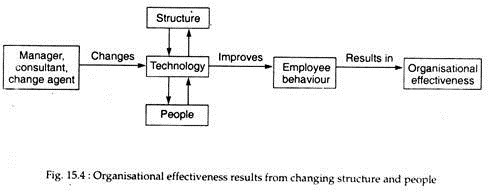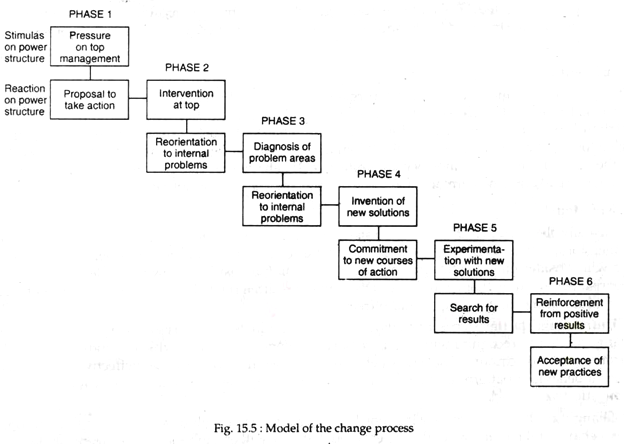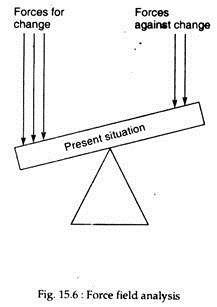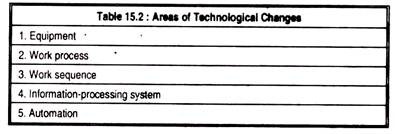After reading this article you will learn about:- 1. The Nature of Organisational Change 2. Planned versus Reactive Organisational Changes 3. Managing Change 4. Reactions 5. Process 6. Resistance 7. Overcoming Resistance 8. Types 9. Organisational Decline and Termination.
Contents:
- The Nature of Organisational Change
- Planned versus Reactive Organisational Changes
- Managing Organisational Change
- Reactions to Organisational Change
- Process of Organisational Change
- Resistance to Organisational Change
- Overcoming Resistance to Organisational Change
- Types of Organisational Changes
- Organisational Decline and Termination
1. The Nature of Organisational Change:
It is often said that nothing is certain but death and taxes. But a third term has to be added — change. In management, change is expected as part of organisational life. Change refers to an alteration in the present business environment.
ADVERTISEMENTS:
Some examples of organisational change are:
(1) A new method of doing the work,
(2) A new product or process,
(3) A new organisation structure and
ADVERTISEMENTS:
(4) Changes in personnel policy or employee benefits.
Every individual and organisation has to experience change. At times the change is planned for.
Sometimes changes are imposed — events beyond the individual’s or organisation’s control initiate the change. In the first situation there exists a great possibility to predict what may happen and thereby to control events. In the second situation, reaction to unforeseen events can be the response. Since change is certain to occur, it has to be managed. So it is necessary at the outset to examine potential sources of change.
Organisation change is defined as “any alteration in one or more elements of the organisation”. Changes can be made in any of the following: work schedules, basis for departmentation, span of management, overall organisation design, or people themselves.
ADVERTISEMENTS:
It is also important to bear in mind that any change in an organisation may have effects extending beyond the actual arena in which the change takes place. For example, a job enrichment programme could require the purchase of new machinery that might, in turn, affect other processes in the work system.
Forces for Change:
In practice, numerous factors affect an organisation and most of these are continuously changing. These forces leading to or causing change originate both within or outside the organisation, as shown in Fig.15.1.
External change forces:
ADVERTISEMENTS:
External forces for change derive from the organisation’s general and task environments. External forces causing changes may include technology, competition, government actions, economic variables and social values. Government regulations on health, safety, and the conduct of business affect an organisation. Labour laws influence hiring, pay, training and promotion decisions. Tax laws change.
Economic conditions- such as recession, money supplies, inflation, and interest rates — are sources of change.
Organisational changes are of three types:
ADVERTISEMENTS:
(i) Technological, made possible by breakthroughs in computer and word-processing technologies,
(ii) Structural, i.e., change in organisational design, made possible by rearranging product groups into, different divisions,
(iii) Human, i.e., changing people in the organisation by improving the managerial ability of top executives.
Paralleling the increased awareness of social and technological change has been a great deal of concern about organisational change.
ADVERTISEMENTS:
As Griffin has rightly put it:
“Changes in any of the elements of the general environment (that is, the economic, international, political, technological and socio-cultural environments) or in the task environment (customers, competitors, associates, unions, regulatory and suppliers) may necessitate a change in the organisation itself. Change may also be brought about internally by a new manager or by the new philosophy of an existing manager.”
In the international element of the general environment, a foreign competitor (such as Canon) might introduce a new product, increase prices, reduce prices, change standards or enter new markets, thus forcing domestic organisations to react.
In the political element, new laws, court decisions and regulations all affect organisations. The technological element may yield new production techniques that the organisation needs to explore.
ADVERTISEMENTS:
Largely due to its proximity to the organisation, the task environment usually is an even more powerful force for change. Competitors obviously influence organisation via their price structures and product lines. Customers determine what products can be sold at what prices. The organisation must constantly be concerned with consumer tastes and preferences.
In a like manner, suppliers affect organisations by raising or lowering prices, changing product lines, or even snapping trade relations with a company. Regulators can have dramatic effects on an organisation. Trade (labour) unions are a force for change when they demand and succeed in getting higher wages or go out on strike. Finally, subsidiaries can spur change as they add to or drain from the resource base of the holding company.
Finally, cultural changes in such areas as modes of dress, reasons for people working, composition of the labour force, and changes in traditional female and male roles can affect the organisational environment. The socio-cultural element, reflecting societal values, determines what kinds of product or services will find a ready market.
It appears that external change forces have a greater effect on organisational change than internal stimuli, as they are diverse and numerous and management has hardly any control over them.
Internal Change Forces:
Pressures for change may also originate from within the organisation. In other words various forces inside the organisation may cause change. These forces might include managerial policies or styles, systems, and procedures; technology and employee attitudes.
ADVERTISEMENTS:
For example, top management’s decision to shift its goal from long-term growth to short-term profit is likely to affect the goals of various departments and may even lead to re-organisation. In short, if top management revises the organisation’s goals, organisational change is likely to result.
A decision by Philips India Ltd. to enter the home computer market or a decision to increase a ten-year product sales goal by 3% would occasion many organisation changes.
Other internal forces may actually be indirect reflections of external forces. As socio-cultural values shift, for example, workers’ attitudes toward their jobs may also shift and they may demand a change in working hours or working conditions.
In such a case, even though the force is rooted in the external environment, the organisation must respond directly to the internal pressure it generates. For example, the development of a new set of expectations for job performance will influence the values and behaviours of the employees affected. The employees could adapt to these expectations to resist them.
However, these two sets of factors are not found in isolation. Rather they are often interrelated.
2. Planned versus Reactive Organisational Changes:
ADVERTISEMENTS:
Organisational changes may be divided into two broad categories — planned and reactive. The fact is that while some organisational change is planned well in advance, other changes come about as a reaction to unexpected events.
As Griffin has put it:
“Planned change is change that is designed and implemented in an orderly and timely fashion in anticipation of future events. Reactive change, on the other hand, is a piece-meal response to problems as they develop. Such a response may have to be hurried so the potential for poorly conceived and poorly executed change is increased”.
As for the choice between the two, planned change is almost always preferable to reactive change.
In the modern world organisational changes occur very frequently. This is why it is often suggested that most companies or divisions of large companies must implement some form of moderate change at least every year and one or more change every 4 to 5 years. Managers who sit back and respond only when they have to are likely to spend a lot of time hastily changing and re-changing things. A more effective approach is to anticipate forces urging change and plan well in advance to deal with them.
Results of ignoring change:
ADVERTISEMENTS:
Knowing what change is and what are its potential source is of strategic importance to the manager. It is equally important for the manager to known when change is needed in an organisation. Unless an organisation plans for, and copes effectively with, the challenge of change, the results can be disastrous. The same reasoning applies to managers and employees, who faces change at an even accelerated pace.
Nature of Organisational Change:
Fig. 15.2 summarises the nature of organisational change. It represents the forces for change and brings into focus the distinction between two types of change—planned and reactive. The important point to note here is that while reactive change emerges as the result of an environmental ‘push’, planned change anticipates this push. In the next section, we outline the general process of Organisation Change, with a stress on planned change.
3. Managing Organisational Change:
Once change is accepted as inevitable and largely (or partly) predictable a manager has to develop proper strategies for managing it. For developing proper strategy the manager must have a philosophy about the dynamics of change.
ADVERTISEMENTS:
Manager’s Philosophy of Change:
A manager’s philosophy of change should encompass at least three elements — trust, organisational learning, and adaptiveness:
1. Trust:
Trust is defined as “an assured reliance on some person or thing, a confident dependence on the character, ability, strength, or truth of someone or something.”
It is felt that a high trust level between managers and employees can lessen the fear of change. Changes tend to threaten habits and security. If a manager has developed an environment of trust, employees are likely to feel more comfortable as the organisation moves through the crises of change.
2. Organisational learning:
ADVERTISEMENTS:
A second component of a manager’s philosophy of change is how the manager and the organisation integrate new ideas into established systems to develop new and better (!) ways of doing things. This concept, known as organisational learning, is a key element in developing a sound philosophy of change.
3. Adaptiveness:
A third element is a managerial commitment to being prepared for change prior to the actual need for it.
In the words of W.R. Plunkett and R.F. Attner:
“Managers who are adaptive rather than reactive will minimise wasted energy and maximise the use of time in a change situation. Establishing a climate of trust, focusing on adapting rather than reacting, and providing for flexibility through understanding organisational learning should enable the manager to be ready to manage organisational change.”
Ways of Dealing with Change:
Management has already been defined as the art and science of getting things done through people. Thus favourable change can be brought about only by working through people.
Fig. 15.3 shows that there are two major ways of dealing with organisational change. The first is a reactive process of change, whereby management adapts on a piecemeal one-step-at-a time manner in order to tackle problems or deal with issues as soon as they arise. An alternative seems to be for management to use the proactive process of change and develop a programme of planned change.
What should be Changed?
If management is to plan for change, it must decide what needs to be changed in the organisation. It is quite obvious that managers seek to change those elements which stand in the way of maximum organisational effectiveness. Organisational effectiveness is the result of activities that improve three most important aspects of an organisation — structure, technology and people.
According to the systems approach, a change in any one of these elements may affect the other two. Thus it is necessary to acknowledge and anticipate the interaction and interrelationships among these three elements. Efforts to change only structure (e.g., job design or work design) or people (e.g., on-the-job training) or technology (e.g., introducing new equipment or layout) is unlikely to bear fruit.
Changing the above three elements improves employee behaviour, leading to greater organisational effectiveness, as illustrated in Fig. 15.4.
4. Reactions to Organisational Change:
When changes occur managers will surely react — either positively or negatively. In fact, resistance to change — for better or worse — is proposed.
Reactions to change are usually of the following types:
1. People may totally deny that change is taking place:
If and when this happens the organisation may gradually lose its effectiveness.
2. People may ignore the change:
Managers may temporarily ignore ‘the take and put off decisions with the expectation that the problems will soon disappear.
3. People may resist the change:
Resistance to change may be (1) emotional, (2) economical, (3) personal and (4) social. It may also be (5) due to fear of failure, (6) due to fear of the unknown, or (7) due to unwillingness to give up existing benefits or programmes. People resist changes for various reasons. In some situations change threatens security.
In others, habits provide a programme method for decision-making. In addition, people have selective perception of situations, which may inhibit change. Finally, people tend to resist change because of actual weakness in the proposed change.
4. People may voluntarily accept change and adapt to it, recognising it as a new way of life.
5. People may also anticipate change and plan for it, in the way modern progressive firms do.
Change is usually supported by managers and employees if it is directed at the real cause of the problem, is an effective solution and does not affect them adversely. But in most cases employees give a neutral response. They prefer to wait and watch.
Most managers consider resistance to change as un-favourable to organisational effectiveness. Thus, when there is resistance, management must re-examine the proposed change to see whether they can find a better solution which is acceptable to all. And such a solution (change) must be brought about through people.
5. Process of Organisational Change:
Understanding the process of change requires careful consideration of the steps in the change process, employee resistance to change and how this resistance can be overcome.
The management of change requires the use of some systematic process that can be divided into a few stages or sub-processes. This is the essence of the most representative model of managing change. It emphasises the role of the change agent who is an outsider, taking a leadership role in initiating and introducing the process of change.
The process of change must involve the following so as to lead to organisational effectiveness. Firstly, there is a re-distribution of power within the organisational structure. Secondly, this redistribution emanates from a developmental change process.
Phases of the Change Process:
Fig.15.5 indicates that the process of change has to pass through six different phases:
1. Internal pressure:
The process of change begins as soon as top management starts feeling a need of pressure for change from within the enterprise. This is usually caused by some significant problem(s) such as sharp drop in sales (profits), serious labour trouble, and/or high labour turnover.
2. Intervention and reorientation:
An external agent is often invited to suggest a definition of the problem and start the process of getting organisation people to focus on it. If internal staff people are competent enough and can be trusted they can also manage the process of change equally well.
3. Diagnosis and recognition of problem(s):
The change agent and manager start gathering necessary information and analyse it so as to recognise the more important problems and give attention to these.
4. Invention of and commitment to solutions:
It is important for the agent to stimulate thought and try to avoid using the ‘same old methods’. Solutions are searched out by creatively developing new and plausible alternatives. If subordinates are encouraged to participate in the process, they will develop a sense of involvement and are likely to be more committed to the course of action finally chosen.
5. Experimentation and search for results:
The solutions developed in phase 4 are normally put to tests on a small-scale (e.g., in pilot programmes) and the results, analysed. If the solution is successful in one unit, or a certain part of a unit, it may be tried in the organisation as a whole.
6. Reinforcement and acceptance:
If the course of action is found desirable (after being properly tested), it should be accepted voluntarily by organisation members. Improved performance should be the source of reinforcement and thus should lead to a commitment to the change.
6. Resistance to Organisational Change:
In planning for change, managers must also take into account the various reasons for which people may resist the change, regardless of how ‘necessary’ it may appear to be.
The following four reasons explain why people resist change:
(i) Uncertainty:
Perhaps the main reason of employee resistance to change is uncertainty. In the face of impending change, employees are likely to become anxious and feel nervous. Diverse feelings among workers may lead to substantial resistance force to change. For example, they may worry about their ability to meet the new job demands, they may think their job security is threatened, or they may simply dislike ambiguity.
(ii) Self-Interests:
Secondly, many impending changes threaten the self-interests of a particular manager or unit. So, he may resist such change.
(iii) Different Perceptions:
It is often observed that a manager recommends a plan for change on the basis of his (her) own assessment of a situation. His peers and subordinates may resist this change because they do not agree with the manager’s assessment or simply perceive the situation differently.
(iv) Feelings of Loss:
Finally, organisational people often resist change simply because of feelings of loss. Many changes involve altering work arrangements, which may disrupt existing social networks. Since social relationships are important to most people, they will resist any change that might adversely affect those relationships. Other intangibles that are threatened by change include power, status, security, familiarity with existing procedures and self-confidence.
7. Overcoming Resistance to Organisational Change:
A manager should not consider himself helpless in the face of resistance to change. Instead he should adopt one of the several strategies available for overcoming it. In fact, various useful strategies have been applied to overcome any type of employee resistance to organisational change.
(i) Participation:
Perhaps the most general and, of course, effective technique for overcoming resistance to change is employee participation. By participating in planning and implementing a change the employees are better able to understand the reasons for the change.
Through participation it is possible to reduce uncertainty and project self-interests and social relationship. If employees get an opportunity to express their own ideas and to assume the perspectives of others, such employees are more likely to accept the change gracefully.
(ii) Education and Communication:
Another way of overcoming resistance to change is employee education which is likely to broaden their horizons. This is very important, as most workers have a myopic vision about the organisation to which they belong.
As John French has commented:
“Educating employees about the need for and the expected results of an impending change should reduce their resistance. And, if open channels of communication are established and maintained during the change process, uncertainty can be minimised”.
(iii) Facilitation:
Change may be slow and gradual or fast and rapid. The recent history of leading corporations indicates that introducing the change gradually can work wonders.
Making only necessary changes, announcing these changes well in advance, and allowing time for people to new ways of doing things are three surest ways of reducing resistance to change.
(iv) Force-Field Analysis:
Force-field analysis can also help overcome resistance to change. Fig. 15.6 shows how force-field analysis relates to the change process. In any change process, there are forces acting for, and for acting against, the change. To facilitate the change, the manager has to strike a balance so that positive forces (i.e., forces working for change) outweigh the negative ones (i.e., forces working against change) such as employee resistance.
It is very important to try to remove or at least minimise forces acting against the change. If a primary force pushing against the change is fear that a new work procedure will break up an existing work group, the manager should try his best to find ways of keeping the group together. If such a solution can be found, one force acting against the change has been eliminated, and this will tip the balance in favour of the change.
8. Types of Organisational Changes:
1. Structural Changes:
According to Harold J. Leavitt there are three general approaches to organisational change: approaches aimed at structure, technology or people. A structural change refers to “a change in any of the basic components of organisation structure or in the organisation’s overall design”. The most important types of such change are summarised in Table 15.1.
An important structural change is related to decentralisation. Due to changes in environmental conditions or management philosophy an organisation could move to become more or less decentralised. It is possible to change spans of management by making them wider or narrower. It is also possible to change an organisation’s present methods of co-ordination.
More and more companies are now introducing job-design changes. According to modern organisation theorists any attempt to adopt job rotation, job enrichment, job design represents a structural change in the organisation. Other examples of such changes are changing work schedules by introducing a modified workweek, flexi-time or job sharing.
Major alterations in an organisation’s overall design are also part of a structural approach to change. Perhaps the most common case seems to be the adoption of a matrix design; clearly, the process of superimposing a product design onto a functional design and the creation of work teams represent major structural change. Other examples include a change from mechanistic to an organic design and a move between any of Mintzberg’s five forms of design.
Other causes of structural change include compensation systems, performance appraisal systems, and control systems. Since these three topics fall in the subject area of personnel management, they may now be briefly reviewed.
(i) Compensation systems:
A compensation system is an arrangement for providing pay, benefits, promotions and other rewards to organisational members. The basic objective of a compensation system should be to stimulate high performance while maintaining an equitable balance of rewards among employees. Various innovative compensation systems have been used in organisations.
The famous Scalon plan suggests that workers and managers should be rewarded for labour savings achieved via improved productivity. Cafeteria benefits plan allow employees to choose the benefit package best suited to their own needs. All-salary plans do away with hourly wages and pay all employees a fixed wage, irrespective of work effort and productivity.
This is comparable to the minimum wage scheme. Finally, reward system participation involves having the employees participate in the design and administration of the organisation’s reward system.
(ii) Performance Appraisal Systems:
An organisation’s performance appraisal system consists of its procedures for determining levels of performance within the organisation. Such systems often include supervisory evaluations using various kinds of rating sales; other systems use objective measures, such as number of units produced or rupee scales volume.
Management by objectives (MBO) is also used in performance appraisal systems. Under the MBO scheme, superior and subordinate collaborate in setting goals for the subordinate and, at the end of a specified time period, actual good achievement is used as the basis for performance appraisal.
The important point to note here is that any shift from one form of performance appraisal to another represents a structural organisational change, because performance appraisal is related to positions in the organisation and to interrelationships among those positions.
(iii) Control Systems:
A control system is a mechanism to ensure that the organisation is making satisfactory progress towards its goals and is not deviating too much from acceptable standards. Examples of contemporary control systems are various accounting systems, programmes for monitoring investments and expenditures, and budgeting innovations such as zero-base budgeting.
Another way to exert control is to focus on minimising work-related accidents. The truth is that by introducing a new control system or changing from one type of control system to another often leads to a structural change in the organisation.
2. Technological Changes:
The technology of an organisation is the conversion process an organisation uses to transfer inputs into outputs. Due to the rapid rate of technological innovation in the industrial world, technological change is becoming increasingly important to many organisations. Table 15.2 lists five major areas where technological change is likely to be experienced.
Change in Equipment:
Perhaps the simplest form of technological change results from a change in equipment inasmuch as technological knowledge is often embodied in new machines and equipment. To keep pace with competitors, many firms find it necessary to periodically replace existing machines and equipment with newer models.
As J.K. Galbraith has commented:
“In a consumer society, the best product you can manufacture is one that must be replaced immediately”.
Change in Work Processes:
A change in work process or work activities may also be necessary if new equipment is introduced, or new products are manufactured.
In manufacturing industries, the major reason for changing a work process is to accommodate a change in the materials used to produce a finished product. An organisation is often found to undergo a major technological change.
As new raw materials and appropriate new production processes are developed, technological change will probably become more pervasive. As Thomas Carlyle has put it: “Man is a tool-using animal; without tools he is nothing, with tools he is all”.
Change in Work Sequence:
A change in work sequence may or may not accompany a change in equipment or a change in work processes. Essentially, making a change in work sequence means altering the order (or sequence) of work stations involved in a particular manufacturing process.
Change in Information-Processing Systems:
Perhaps the most important type of technological change that has been especially important in recent years is change in information-processing systems. Simultaneous advances in large mainframe computers, personal computers and network tie-in systems have created vast potential for change in most work places. The main idea behind the adoption of computers in offices is the creation of an information-processing station for each employee.
Automation:
Automation is the process of designing work so that it can be completely or almost completely performed by machines. As with most information-processing systems, computers play a major role in the upsurge of automation. Automated and computerised industry requires more and more young men and women who have white-collar skills but behave with the docility expected of blue-collar workers.
The advent of automation has perhaps been most visible in the automobile industry, just as technological change has been really spectacular in the computer industry.
3. Person-Focussed Changes:
The third area of organisation is conceived with human resources. Person-focussed changes might be conceived with changing employee performance, skills, attitudes, perceptions, behaviours or expectations. Such changes are considered part of organisational development. Here, it suffices to focus on efforts to upgrade employee skills and performance. See Table 15.3
Replacement of Human Resources:
There are many reasons why replacement of one or more employees may be desirable. A change in work processes may require that employees be able to operate new kinds of equipment. If no amount of training can increase the capabilities of an existing equipment operator, it may become necessary to replace the operator.
Or, a behavioural problem may arise that cannot be solved by any other means. Suppose that two or more employees simply are not able to work together; one is a heavy smoker and the other a militant nonsmoker. It may be necessary to replace one (or both) of these individuals.
Of course, replacement is not limited to the operating ranks. Managers may also allow their skills to become obsolete, or they may not be able to cope with a rapidly changing marketplace. The organisation may find it necessary to replace such managers with others who are better able to satisfy the demands of the job.
Several different methods for dealing with “replaced” employees are available. Responding to their sense of social responsibility, managers sometimes try to find work for replaced employees with other companies, especially when the employee has logged many years of productive service.
Early retirement is another option, and it is becoming increasingly popular. And, of course, the employee could simply be transferred to another job or department. In other cases, it may be necessary to terminate the employee and sever her or his relationship with the organisation.
Selection:
Another “person-focused” change strategy is selection, which takes a longer-term perspective than replacement. The idea is that the organisation fine-tunes or upgrades its selection criteria so as gradually to achieve a significant change in its human resources.
An organisation may decide that henceforth it will hire only college graduates for its management training program. Assuming that a college degree has some validity as a predictor of managerial success, the overall quality of the organisation’s management group should gradually improve as the new managers enter the organisation.
After a while, the organisation might raise its standards again and hire only management trainees who hold an M.B.A. degree. Again, assuming the validity of the degree, management quality should continue to rise. Finally, the criteria might be set an M.B.A. plus five years of work experience.
Of course, the organisation must make sure that it really needs such a highly qualified (and hence more expensive) set of managers and that the new standards do not discriminate against women and minorities.
Training and Development:
A final technique for changing employee skills and performance is training and development. Whereas replacement and selection are concerned with replacing existing employees with new ones, training and development involve refining the skills and boosting the performance levels of existing employees.
When a new piece of equipment is installed, it may well be possible to train an existing employee to operate it. Similarly, managerial skills can be developed and maintained to help managers keep pace with changes in their work environment.
9. Organisational Decline and Termination:
All types of organisational change are neither desirable nor welcome. There may be a different kind of organisational change that most managers try to avoid. For various reasons, organisations may start declining in size, sales or assets and may eventually cease to exist.
It should not be missed that this decline and the possible demise of the firm are also facets of organisational change, and they are not uncommon:
1. In recent years, many large organisations have been terminated.
2. Approximately 50% of all new businesses fail during the first year.
3. The late 1980s were characterised by major cutbacks in organisation size and layoffs in many organisations.
4. Many organisations are purchased by other organisations and cease to exist as autonomous entities.
Table 15.5 lists the major causes of decline and termination and as also various ways in which the organisation may respond.
Causes of Decline and Termination:
Various factors may cause decline and potential termination, but the real cause seems to be poor management, which may include anything from choosing a wrong location for a new business to over investing in capital equipment to being too generous with customer credit. In India, we refer to organisational decline as industrial sickness.
Obsolescence occurs when an organisation’s products or services are replaced by more desirable products or services. For example, personal computers made both manual and electric typewriters obsolete. Growing intensity of competition may also be a cause of decline or termination. Economic conditions may also hurt specific businesses.
During recession, there is a fall in demand for houses and the construction industry receives a severe jolt. Government policy relating to control and regulation of business may also result in decline or termination. Various other (unforeseen) factors can also plunge an organisation into decline, but astute management can anticipate and deal with most of them.
Approaches to Decline:
Organisations have several strategies to cut back. Prima facie, human resource cutbacks can be accomplished through layoffs, transfers, attrition, early retirement or release of employees. Secondly, physical assets cutbacks may mean selling a manufacturing plant, a warehouse, a computer, an office building, or surplus inventory (at cost or below). Finally, financial cutbacks include reduction in operating budgets and freezes on hiring. Divestiture involves selling complete divisions or units to other organisations.
Approaches to Termination:
When an organisation is unable to meet its financial commitments through cost reduction measures, or when it is unable to raise necessary funds f6r current operations then termination seems to be the only viable solution, because in such situations the policy should be one of loss minimization rather than profit maximisation. India sick units are taken over by the government.
The three primary approaches to termination are: liquidation, merger and transformation.
Liquidation:
The most obvious solution is liquidation, i.e., closing down all phases of the organisation, turning all assets into cash, and using them to pay creditors. If there is any residue (surplus) it is distributed among the shareholders.
Merger:
A merger involves selling all or part of the organisation to another firm. The acquiring firm may have the resources and management expertise to set things right.
Transformation:
Finally, the organisation might attempt transformation, which is perhaps the most difficult form of termination. A transformation is a change not just in the organisation structure but (very often) from one kind of business to another.
